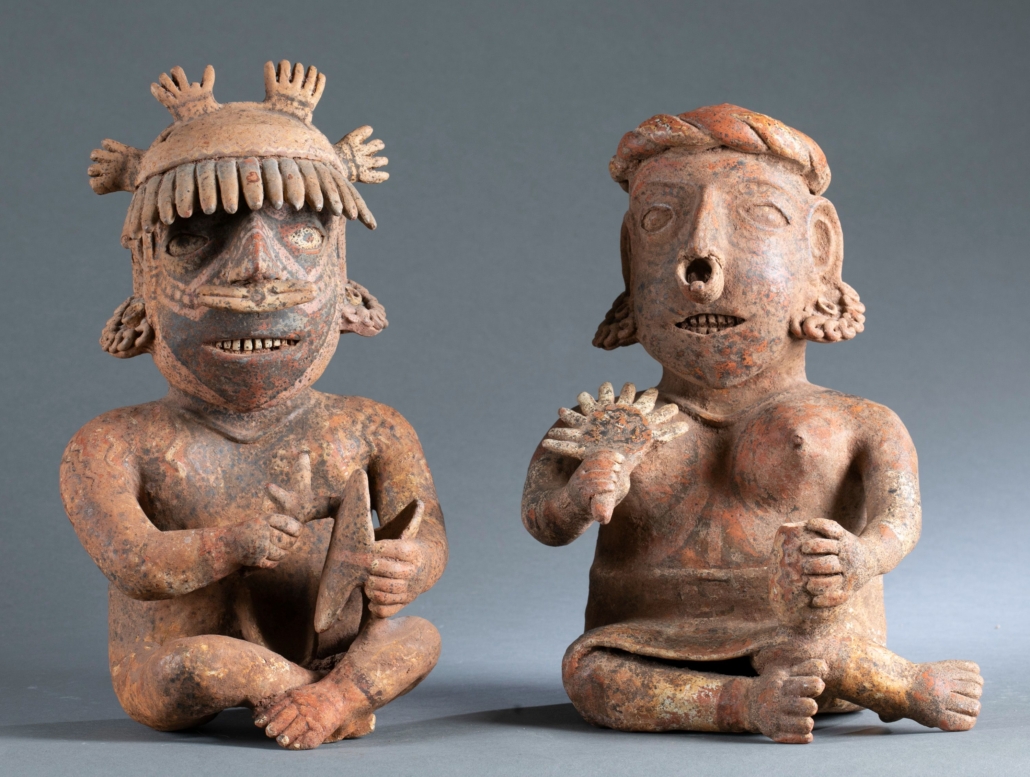
FALLS CHURCH, Va. – Quinn’s Auction Galleries of northern Virginia is proud to present a November 3rd Pre-Columbian and Ethnographic Arts Auction featuring a fine array of Pre-Columbian ceramics from Peru, Mexico, Guatemala, and Costa Rica; as well as African figures, masks, paintings, and utilitarian objects.
Featured: Las Bocas Olmec (Mexico) figure, Maya (Guatemala) plumbate dog, Jaina (Yucatan) figures, 1983 Cheri Samba (Congo) social commentary painting
More than three dozen pieces come with provenance from highly distinguished collections or noteworthy auctions of the past. Among those esteemed sources are: Harold E Rayburn (12 objects), Peter Wray (8 objects), Ted Van Dyke (5 objects), Frances Pratt (2 objects), and Merrill Rueppel for the Merrill Gallery (2 objects). Five lots were formerly the property of A. Emmerich Gallery, and another five were auctioned by Sotheby’s Parke-Bernet in New York. Sotheby’s Parke-Bernet was an interim name used in the 1970s for the auction house previously known as Parke-Bernet that became an arm of London’s Sotheby’s after its purchase in 1964. By the mid-1970s, the Parke-Bernet had been phased out entirely, and from then on, only Sotheby’s name was used.
Standouts among the many highlights include a Las Bocas Olmec seated figure from Mexico, a Maya plumbate dog from Guatemala, and a 1983 Cheri Samba painting from the Democratic Republic of the Congo. It is an online-only auction with Internet live bidding through LiveAuctioneers.
The rich array of Pre-Columbian art is led by a Las Bocas Olmec seated figure displaying all of the correct characteristics and physical attitudes of Las Bocas (Puebla, Mexico) human-figural pottery. The figure has a downturned mouth and leans on the right hand, with the left arm raised. The knees are slightly bent, and the head is tilted slightly to the left, while the mouth is downturned. The 3¾-inch-high figure crafted of burnished buff to orange ceramic dates to the Middle Formative period, 900 to 600 BCE, and is estimated at $10,000-$15,000.
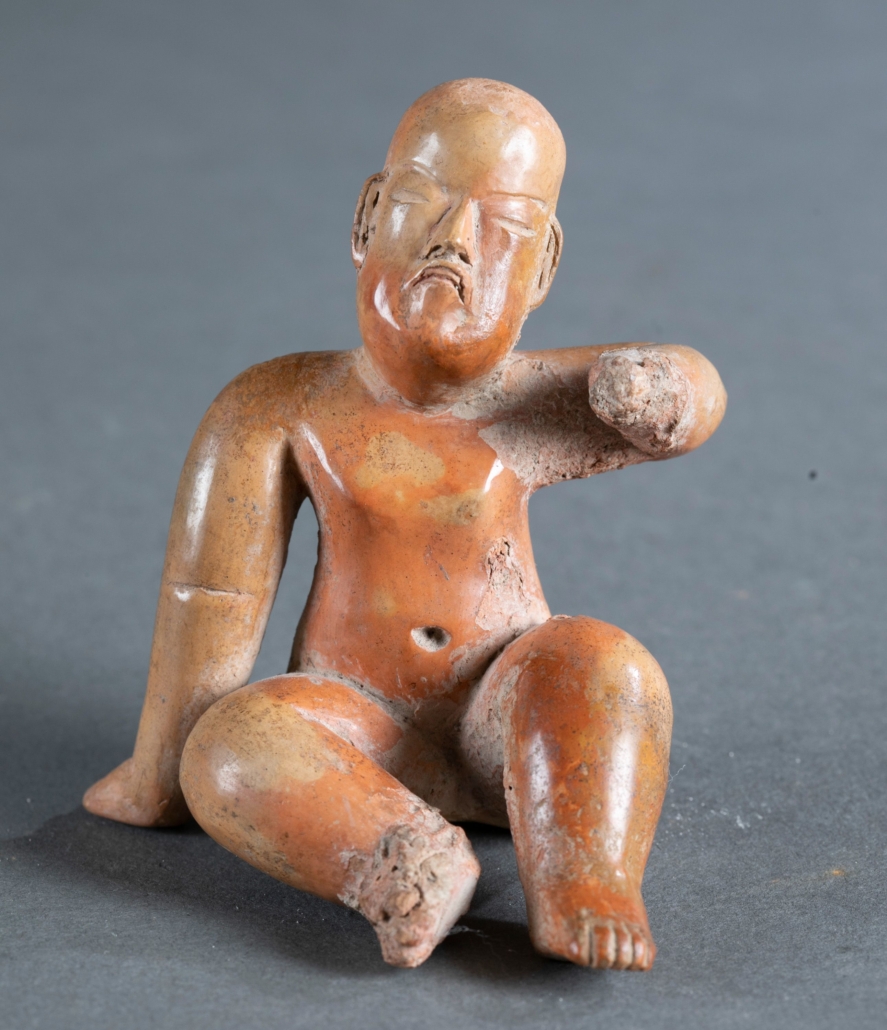
Also from the Las Bocas Central Valley region of Mexico, but an earlier production (Early Formative period, 1200-900 BCE), an elegant, gently sloping tecomate (globular bowl) is composed of burnished, white-slipped ceramic. The perfectly proportioned 3¾- by 4¼-inch piece is estimated at $3,000-$5,000.
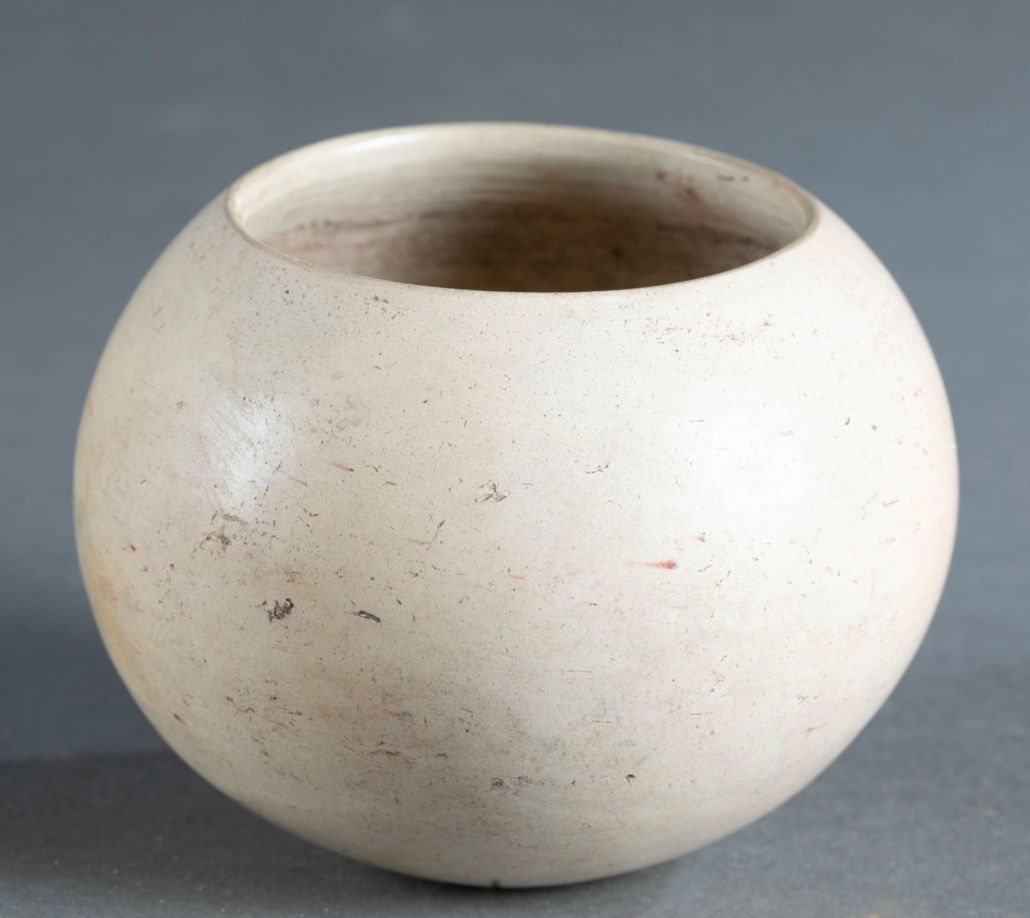
Vacationers who flock to the modern resorts and idyllic beaches of Puerto Vallarta might not even realize that the Mexican state of Nayarit, a mere 15 minutes away, has yielded some of Mexico’s greatest archaeological treasures. On November 3rd, Quinn’s will offer a duo of Nayarit seated musician figures (shown at top of this page). The male has one leg crossed over the other and holds a shell instrument. His mouth is slightly open to reveal a row of white teeth. The other figure, a woman with ear ornamentations, holds an instrument that might be a type of rattle. Both figures are of reddish ceramic with pigments and manganese, and date to 200 BCE to 200 CE. The smaller of the two measures 15 inches by 10 inches; the larger is 15¼ by 8 inches. Lot estimate: $4,000-$6,000.
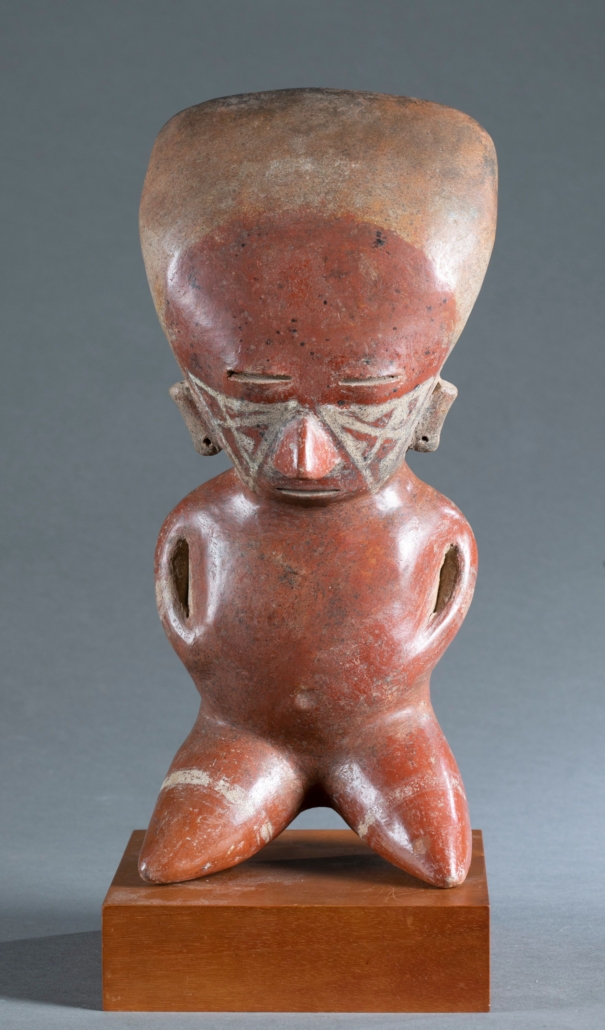
A Nayarit seated figure of burnished red ceramic has a large, prominent forehead with slashes decorating her face. She is depicted in the birthing position, her short, conical-shape legs decorated with single white bands and her arms held close to the body. From the Late Formative period, 300 BCE to 200 CE, the figure stands 16inches high (inclusive of mount) and is entered with a $3,000-$5,000 estimate.

A Veracruz standing figure with elaborate regalia and a ‘feathered,’ rectangular-shape backrack frame holds a staff with a central motif possibly meant to be a mirror. Three vertical shafts extend from the top of the figure’s head, and a profusely detailed mask is attached to the front of the loincloth. The entire piece is made of buff-colored ceramic and originated during the Late Classic period, 50 to 950 CE. With its mount, the figure stands 24½ inches high. Estimate: $3,000-$5,000
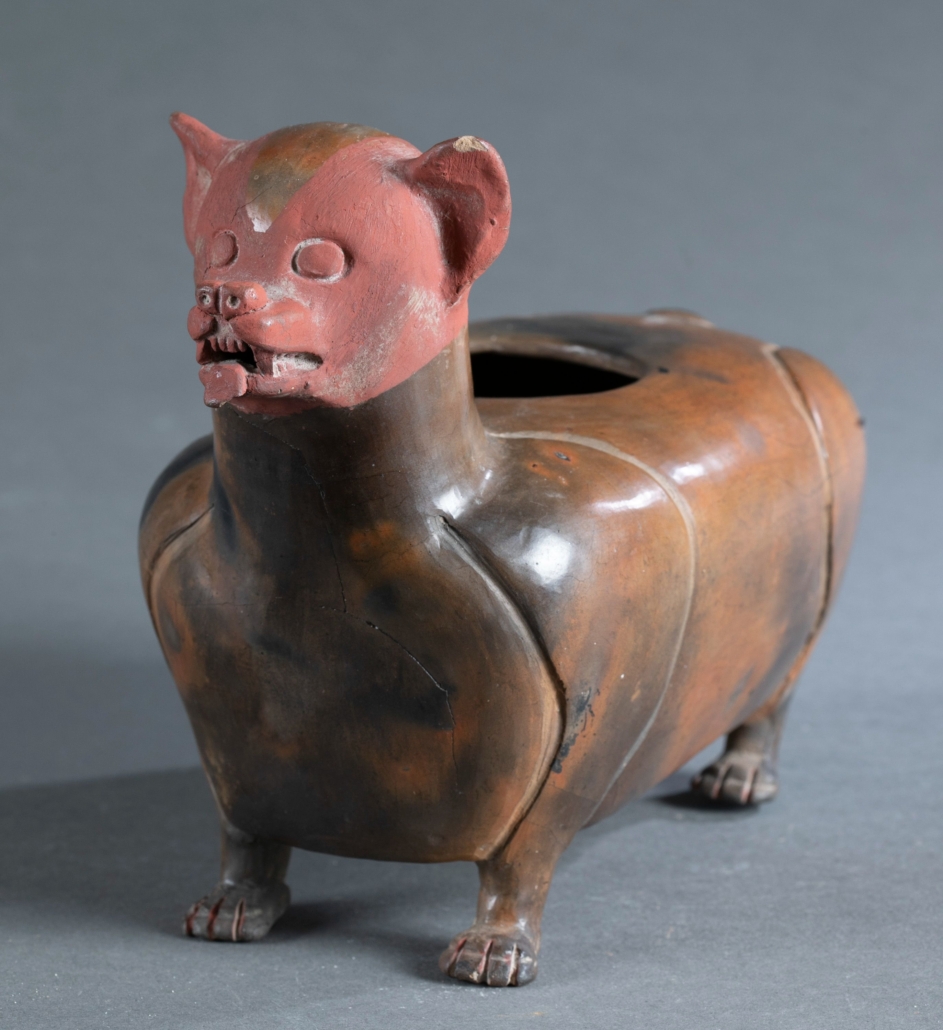
Certainly one of the most popular forms of Pre-Columbian Central American pottery is the three-dimensional dog, sometimes appearing overly plump and at other times displaying a physique that is more suggestive of the modern-day Chihuahua breed. Quinn’s offers in its November 3rd auction an unusual Maya vessel fashioned as a dog on four thin, straight legs with a circular opening on its back. The 7-inch-long by 5-inch-high body is of burnished brown ceramic with red-orange slip, and the head has been painted red with the exception of a brown stripe between the ears. The canine’s mouth is open, with the tongue extended and several teeth visible. Of Guatemalan origin and dating to 600-900 CE, this highly unusual form is estimated at $4,000-$6,000.
Jaina Island is a Pre-Columbian Maya archaeological site on the Yucatan Peninsula’s Gulf Coast, with only a tidal inlet separating it from the mainland. Jaina, which translates to “temple in the water,” served as an elite Maya burial site. Figures found during excavations in the area are thought by many experts to be the finest examples produced anywhere in the ancient Americas.
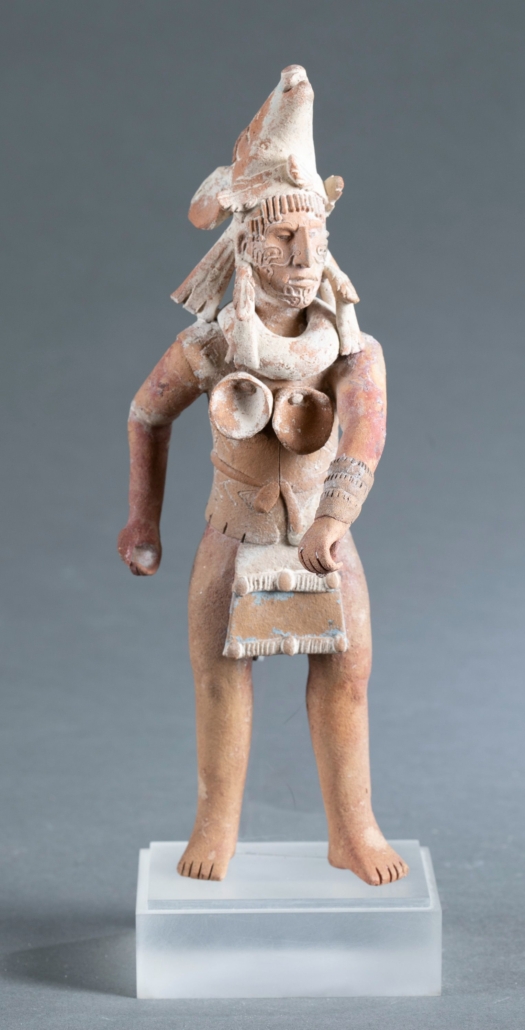
The auction includes two Jaina artifacts worthy of special note. One is a standing male warrior figure holding what might be a spear fragment. The buff ceramic figure wears a pendant consisting of two large, round pectoral plates, and an animal headdress that has the features of a deer. The facial scarification and costuming suggest the subject was a man of importance. Produced in the Late Classic period, 600 to 900 CE, the figure stands 11 inches high (inclusive of mount) and carries a $5,000-$10,000 estimate.
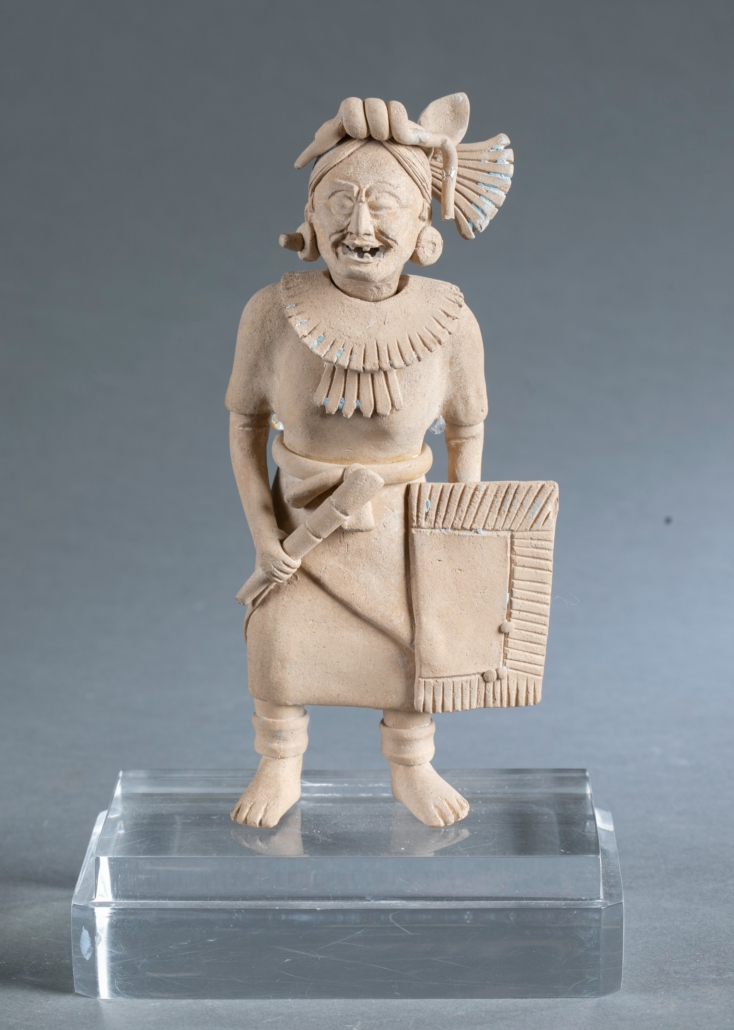
A second Jaina figure from the Late Classic period, also composed of buff-colored ceramic, wears ear spools, a cape and feathered collar; ankle bracelets and a belt. He holds a club in one hand and a shield in the other, and his mouth is open, with teeth visible. Including its mount, the figure stands 9½ inches high. The pre-auction estimate is $8,000-$12,000.
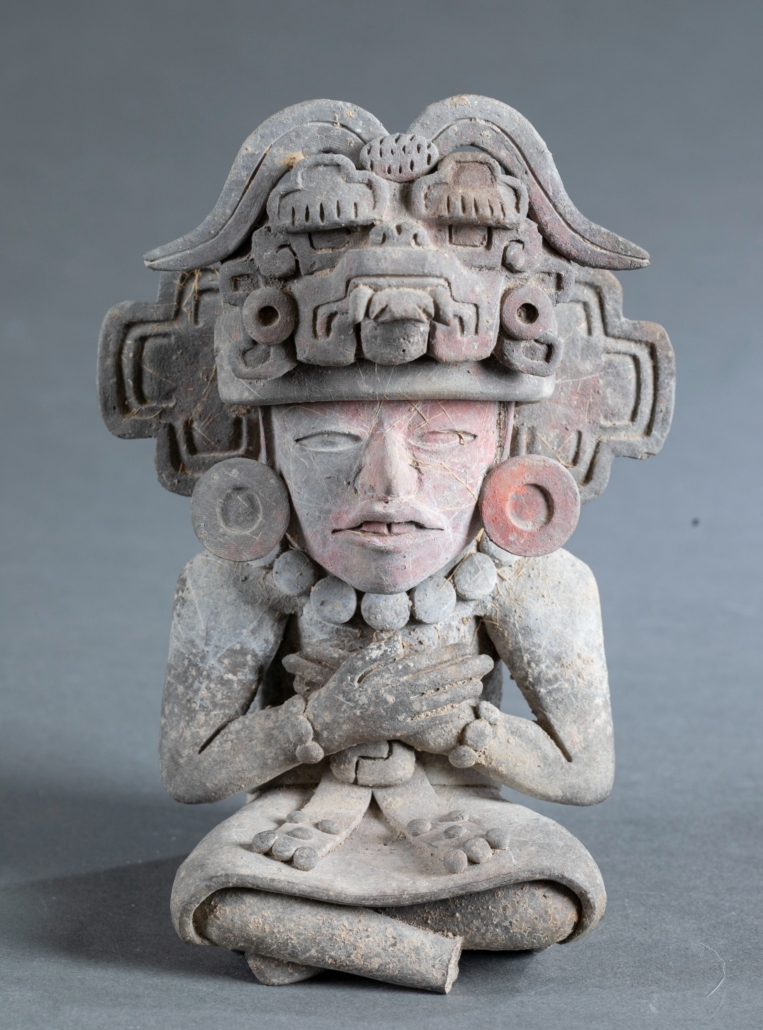
The last of the Pre-Columbian highlights is a Zapotec (Oaxaca, Mexico) seated figure with an elaborate headdress. The man’s hands are held close to the chest, and his legs are crossed. Composed of gray ceramic with red pigment and traces of red cinnabar to the face, this compelling 7¼-inch-high figure is from the Early Classic period, 200 to 300 CE. Estimate: $1,500-$2,500
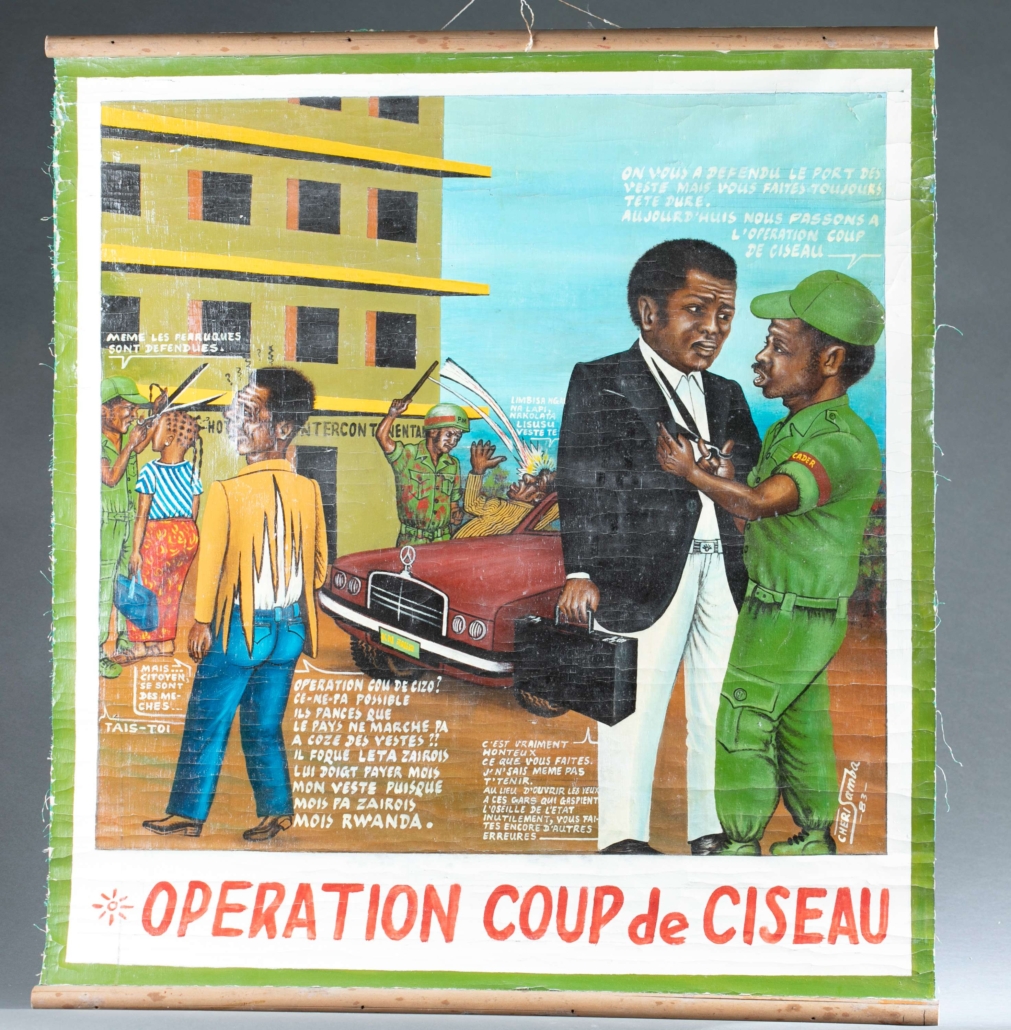
As contemporary African art continues to gain prominence, increasing attention is being paid to artists like Cheri Samba (Congolese, b. 1956-). His “new century” works – some of which are held in the collections of the Centre Georges Pompidou in Paris and the Museum of Modern Art in New York – are distinguished by the fact that they almost always include text in French and Lingala. Samba’s paintings are commentaries on life in Africa and the modern world. His 1983 work titled Operation Coup de Ciseau (Operation Coup of Scissors) is on cut canvas placed to scroll. The scene depicts uniformed officers using shears to deface the clothing of everyday people who have dressed in Western style. Artist-signed and dated at lower right, the 35¾-inch by 32 3/8-inch artwork is estimated at $4,000-$6,000.
Quinn’s Auction Galleries’ Thursday, Nov. 3, 2022 Pre-Columbian and Ethnographic Arts Auction will start at 2 p.m. EST. For additional information on any item in the auction, call 703-532-5632. For questions or a condition report, email corrie.brady@quinnsauction.com.
View top auction results on LiveAuctioneers here: https://www.liveauctioneers.com/pages/recent-auction-sales/



